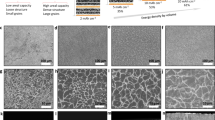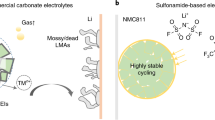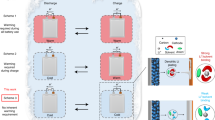Abstract
Operations of lithium-ion batteries have long been limited to a narrow temperature range close to room temperature. At elevated temperatures, cycling degradation speeds up due to enhanced side reactions, especially when high-reactivity lithium metal is used as the anode. Here, we demonstrate enhanced performance in lithium metal batteries operated at elevated temperatures. In an ether-based electrolyte at 60 °C, an average Coulombic efficiency of 99.3% is obtained and more than 300 stable cycles are realized, but, at 20 °C, the Coulombic efficiency drops dramatically within 75 cycles, corresponding to an average Coulombic efficiency of 90.2%. Cryo-electron microscopy reveals a drastically different solid electrolyte interface nanostructure emerging at 60 °C, which maintains mechanical stability, inhibits continuous side reactions and guarantees good cycling stability and low electrochemical impedance. Furthermore, larger lithium particles grown at the elevated temperature reduce the electrolyte/electrode interfacial area, which decreases the per-cycle lithium loss and enables higher Coulombic efficiencies.
This is a preview of subscription content, access via your institution
Access options
Access Nature and 54 other Nature Portfolio journals
Get Nature+, our best-value online-access subscription
$29.99 / 30 days
cancel any time
Subscribe to this journal
Receive 12 digital issues and online access to articles
$119.00 per year
only $9.92 per issue
Buy this article
- Purchase on Springer Link
- Instant access to full article PDF
Prices may be subject to local taxes which are calculated during checkout






Similar content being viewed by others
Data availability
The data that support the plots within this paper and other findings of this study are available from the corresponding author upon reasonable request.
References
Tarascon, J. M. & Armand, M. Issues and challenges facing rechargeable lithium batteries. Nature 414, 359–367 (2001).
Chu, S. & Majumdar, A. Opportunities and challenges for a sustainable energy future. Nature 488, 294–303 (2012).
Leng, F., Tan, C. M. & Pecht, M. Effect of temperature on the aging rate of Li ion battery operating above room temperature. Sci. Rep. 5, 12967 (2015).
Lithium Ion Rechargeable Batteries: Technical Handbook (Sony Corporation, 2009); https://cdn.sparkfun.com/datasheets/Prototyping/Lithium%20Ion%20Battery%20MSDS.pdf
Cho, H.-M., Choi, W.-S., Go, J.-Y., Bae, S.-E. & Shi, H.-C. A study on time-dependent low temperature power performance of a lithium-ion battery. J. Power Sources 198, 273–280 (2012).
Zhang, S. S., Xu, K. & Jow, T. R. Electrochemical impedance study on the low temperature of Li-ion batteries. Electrochim. Acta 49, 1057–1061 (2004).
Sides, C. R. & Martin, C. R. Nanostructured electrodes and the low-temperature performance of Li-ion batteries. Adv. Mater. 17, 125–128 (2005).
Ishikawa, M., Kanemoto, M. & Morita, M. Control of lithium metal anode cycleability by electrolyte temperature. J. Power Sources 81–82, 217–220 (1999).
Yang, X.-G., Zhang, G., Ge, S. & Wang, C.-Y. Fast charging of lithium-ion batteries at all temperatures. Proc. Natl Acad. Sci. USA 115, 7266–7271 (2018).
Yan, P. et al. Tailoring grain boundary structures and chemistry of Ni-rich layered cathodes for enhanced cycle stability of lithium-ion batteries. Nat. Energy 3, 600–605 (2018).
Ramadass, P., Haran, B., White, R. & Popov, B. N. Capacity fade of Sony 18650 cells cycled at elevated temperatures Part I. Cycling performance. J. Power Sources 112, 606–613 (2002).
Liu, D.-Q., Liu, X.-Q. & He, Z.-Z. The elevated temperature performance of LiMn2O4 coated with Li4Ti5O12 for lithium ion battery. Mater. Chem. Phys. 105, 362–366 (2007).
Shim, J., Kostecki, R., Richardson, T., Song, X. & Striebel, K. A. Electrochemical analysis for cycle performance and capacity fading of a lithium-ion battery cycled at elevated temperature. J. Power Sources 112, 222–230 (2002).
Waldmann, T., Wilka, M., Kasper, M., Fleischhammer, M. & Wohlfahrt-Mehrens, M. Temperature dependent ageing mechanisms in lithium-ion batteries—a post-mortem study. J. Power Sources 262, 129–135 (2014).
Jung, H.-G., Jang, M. W., Hassoun, J., Sun, Y.-K. & Scrosati, B. A high-rate long-life Li4Ti5O12/ Li[Ni0.45Co0.1Mn1.45]O4 lithium-ion battery. Nat. Commun. 2, 516 (2011).
Schimpe, M. et al. Comprehensive modeling of temperature-dependent degradation mechanisms in lithium iron phosphate batteries. J. Electrochem. Soc. 165, A181–A193 (2018).
Xu, W. et al. Lithium metal anodes for rechargeable batteries. Energy Environ. Sci. 7, 513–537 (2014).
Tikekar, M. D., Choudhury, S., Tu, Z. & Archer, L. A. Design principles for electrolytes and interfaces for stable lithium-metal batteries. Nat. Energy 1, 16114 (2016).
Lin, D., Liu, Y. & Cui, Y. Reviving the lithium metal anode for high-energy batteries. Nat. Nanotechnol. 12, 194–206 (2017).
Xu, K. Nonaqueous liquid electrolytes for lithium-based rechargeable batteries. Chem. Rev. 104, 4303–4417 (2004).
Xu, K. Electrolytes and interphases in Li-ion batteries and beyond. Chem. Rev. 114, 11503–11618 (2014).
Li, L. et al. Self-heating-induced healing of lithium dendrites. Science 359, 1513–1516 (2018).
Winter, M. The solid electrolyte interphase—the most important and the least understood solid electrolyte in rechargeable Li batteries. Z. Phys. Chem. 223, 1395–1406 (2009).
Wang, A., Kadam, S., Li, H., Shi, S. & Qi, Y. Review on modeling of the anode solid electrolyte interphase (SEI) for lithium-ion batteries. npj Comput. Mater. 4, 15 (2018).
Li, Y. et al. Atomic structure of sensitive battery materials and interfaces revealed by cryo-electron microscopy. Science 358, 506–510 (2017).
Li, Y. et al. Correlating structure and function of battery interphases at atomic resolution using cryo-electron microscopy. Joule 2, 2167–2177 (2018).
Zachman, M. J., Tu, Z., Choudhury, S., Archer, L. A. & Kourkoutis, L. F. Cryo-STEM mapping of solid–liquid interfaces and dendrites in lithium-metal batteries. Nature 560, 345–349 (2018).
Aurbach, D., Ein‐Ely, Y. & Zaban, A. The surface chemistry of lithium electrodes in alkyl carbonate solutions. J. Electrochem. Soc. 141, L1–L3 (1994).
Mogensen, R., Brandell, D. & Younesi, R. Solubility of the solid electrolyte interphase (SEI) in sodium ion batteries. ACS Energy Lett. 1, 1173–1178 (2016).
Pan, H. et al. Addressing passivation in lithium–sulfur battery under lean electrolyte condition. Adv. Funct. Mater. 0, 1707234 (2018).
Mikhaylik, Y. V. Electrolytes for lithium sulfur cells. US patent 7,354,680 B2 (2008).
Pei, A., Zheng, G., Shi, F., Li, Y. & Cui, Y. Nanoscale nucleation and growth of electrodeposited lithium metal. Nano Lett. 17, 1132–1139 (2017).
Ely, D. R. & Garcia, R. E. Heterogeneous nucleation and growth of lithium electrodeposits on negative electrodes. J. Electrochem. Soc. 160, A662–A668 (2013).
Wang, F.-M. et al. Aging effects to solid electrolyte interface (SEI) membrane formation and the performance analysis of lithium ion batteries. Int. J. Electrochem. Sci. 6, 1014–1026 (2011).
Liu, Y. et al. An artifcial solid electrolyte interphase with high Li-ion conductivity, mechanical strength, and flexibility for stable lithium metal anodes. Adv. Mater. 29, 1605531 (2017).
Tu, Z. et al. Nanoporous hybrid electrolytes for high-energy batteries based on reactive metal anodes. Adv. Energy Mater. 7, 1602367 (2017).
Hu, Q. et al. Graft copolymer-based lithium-ion battery for high-temperature operation. J. Power Sources 196, 5604–5610 (2011).
Acknowledgements
Y.C. acknowledges support from the Assistant Secretary for Energy Efficiency and Renewable Energy, Office of Vehicle Technologies, Battery Materials Research (BMR) Program and Battery 500 Consortium of the US Department of Energy, Stanford Global Climate and Energy Projects (GCEP), the Office of Naval Research, the Joint Center for Energy Storage Research (JCESR) and a KAUST Investigator Award. A.P. acknowledges support from the National Defense Science and Engineering Graduate Fellowship and the Stanford Graduate Fellowship. Part of this work was performed at the Stanford Nano Shared Facilities (SNSF), supported by the National Science Foundation under award ECCS-1542152.
Author information
Authors and Affiliations
Contributions
J.W., A.P. and Y.C. conceived and designed the experiments. J.W. and A.P. performed the experiments. W.H. and Y.L. conducted TEM characterization. J.W., A.P., W.H. and Y.C. co-wrote the paper. All authors discussed the results and commented on the manuscript.
Corresponding author
Ethics declarations
Competing interests
The authors declare no competing interests.
Additional information
Publisher’s note: Springer Nature remains neutral with regard to jurisdictional claims in published maps and institutional affiliations.
Supplementary Information
Supplementary information
Supplementary Figs. 1–12
Rights and permissions
About this article
Cite this article
Wang, J., Huang, W., Pei, A. et al. Improving cyclability of Li metal batteries at elevated temperatures and its origin revealed by cryo-electron microscopy. Nat Energy 4, 664–670 (2019). https://doi.org/10.1038/s41560-019-0413-3
Received:
Accepted:
Published:
Issue Date:
DOI: https://doi.org/10.1038/s41560-019-0413-3
This article is cited by
-
Metal electrodes for next-generation rechargeable batteries
Nature Reviews Electrical Engineering (2024)
-
From Liquid to Solid-State Lithium Metal Batteries: Fundamental Issues and Recent Developments
Nano-Micro Letters (2024)
-
Investigating microstructure evolution of lithium metal during plating and stripping via operando X-ray tomographic microscopy
Nature Communications (2023)
-
Low-temperature anode-free potassium metal batteries
Nature Communications (2023)
-
Growing single-crystalline seeds on lithiophobic substrates to enable fast-charging lithium-metal batteries
Nature Energy (2023)



